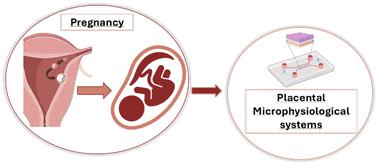Our official English website, www.x-mol.net, welcomes your
feedback! (Note: you will need to create a separate account there.)
Placental microphysiological systems: new advances on promising platforms that mimic the microenvironment of the human placenta
Lab on a Chip ( IF 6.1 ) Pub Date : 2024-10-17 , DOI: 10.1039/d4lc00500g Inês M. Gonçalves, Muhammad Afzal, Nithil Kennedy, Ana Moita, Rui Lima, Serge Ostrovidov, Takeshi Hori, Yuji Nashimoto, Hirokazu Kaji
Lab on a Chip ( IF 6.1 ) Pub Date : 2024-10-17 , DOI: 10.1039/d4lc00500g Inês M. Gonçalves, Muhammad Afzal, Nithil Kennedy, Ana Moita, Rui Lima, Serge Ostrovidov, Takeshi Hori, Yuji Nashimoto, Hirokazu Kaji

|
One of the most complex human physiological processes to study is pregnancy. Standard animal models, as well as two-dimensional models, lack the complexity and biological relevance required to accurately study such a physiological process. Recent studies have focused on the development of three-dimensional models based on microfluidic systems, designated as placental microphysiological systems (PMPSs). PMPS devices provide a model of the placental barrier through culturing relevant cell types in specific arrangements and media to mimic the in vivo environment of the maternal–fetal circulation. Here, recent developments of PMPS models for embryo uterine implantation, preeclampsia evaluation, and toxicological screening are presented. Studies that use bioprinting techniques are also discussed. Lastly, recent developments in endometrium microphysiological systems are reviewed. All these presented models showed their superiority compared to standard models in recapitulating the biological environment seen in vivo. However, several limitations regarding the types of cells and materials used for these systems were also widely reported. Despite the need for further improvements, PMPS models contribute to a better understanding of the biological mechanisms surrounding pregnancy and the respective pathologies.
中文翻译:

胎盘微生理系统:模拟人类胎盘微环境的有前途的平台的新进展
需要研究的最复杂的人类生理过程之一是怀孕。标准动物模型以及二维模型缺乏准确研究这种生理过程所需的复杂性和生物学相关性。最近的研究集中在基于微流体系统的三维模型的开发上,称为胎盘微生理系统 (PMPS)。PMPS 设备通过在特定排列和培养基中培养相关细胞类型来模拟母胎循环的体内环境,从而提供胎盘屏障模型。在这里,介绍了用于胚胎子宫植入、子痫前期评估和毒理学筛查的 PMPS 模型的最新发展。还讨论了使用生物打印技术的研究。最后,回顾了子宫内膜微生理系统的最新发展。所有这些提出的模型都显示出它们在概括体内生物环境方面优于标准模型。然而,关于用于这些系统的细胞类型和材料的一些限制也被广泛报道。尽管需要进一步改进,但 PMPS 模型有助于更好地了解围绕怀孕的生物学机制和相应的病理。
更新日期:2024-10-17
中文翻译:

胎盘微生理系统:模拟人类胎盘微环境的有前途的平台的新进展
需要研究的最复杂的人类生理过程之一是怀孕。标准动物模型以及二维模型缺乏准确研究这种生理过程所需的复杂性和生物学相关性。最近的研究集中在基于微流体系统的三维模型的开发上,称为胎盘微生理系统 (PMPS)。PMPS 设备通过在特定排列和培养基中培养相关细胞类型来模拟母胎循环的体内环境,从而提供胎盘屏障模型。在这里,介绍了用于胚胎子宫植入、子痫前期评估和毒理学筛查的 PMPS 模型的最新发展。还讨论了使用生物打印技术的研究。最后,回顾了子宫内膜微生理系统的最新发展。所有这些提出的模型都显示出它们在概括体内生物环境方面优于标准模型。然而,关于用于这些系统的细胞类型和材料的一些限制也被广泛报道。尽管需要进一步改进,但 PMPS 模型有助于更好地了解围绕怀孕的生物学机制和相应的病理。































 京公网安备 11010802027423号
京公网安备 11010802027423号